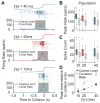Synchronized neural input shapes stimulus selectivity in a collision-detecting neuron
- PMID: 21055939
- PMCID: PMC2998055
- DOI: 10.1016/j.cub.2010.10.025
Synchronized neural input shapes stimulus selectivity in a collision-detecting neuron
Abstract
How higher-order sensory neurons generate complex selectivity from their simpler inputs is a fundamental question in neuroscience. The lobula giant movement detector (LGMD) is such a visual neuron in the locust Schistocerca americana that responds selectively to objects approaching on a collision course or their two-dimensional projections, looming stimuli [1-4]. To study how this selectivity arises, we designed an apparatus allowing us to stimulate, individually and independently, a sizable fraction of the ∼15,000 elementary visual inputs impinging retinotopically onto the LGMD's dendritic fan [5-7] (Figure 1Ai). We then recorded intracellularly in vivo throughout the visual pathway, assessing the LGMD's activity and that of all three successive presynaptic stages conveying local excitatory inputs. Our results suggest that as collision becomes increasingly imminent, the strength of these inputs increases, whereas their latency decreases. This latency decrease favors summation of inputs activated sequentially throughout the looming sequence, making the neuron maximally sensitive to collision-bound trajectories. Thus, the LGMD's selectivity arises partially from presynaptic mechanisms that synchronize a large population of inputs during a looming stimulus and subsequent detection by postsynaptic mechanisms within the neuron itself. Analogous mechanisms are likely to underlie the tuning properties of visual neurons in other species as well.
Copyright © 2010 Elsevier Ltd. All rights reserved.
Figures




Similar articles
-
Fine and distributed subcellular retinotopy of excitatory inputs to the dendritic tree of a collision-detecting neuron.J Neurophysiol. 2016 Jun 1;115(6):3101-12. doi: 10.1152/jn.00044.2016. Epub 2016 Mar 23. J Neurophysiol. 2016. PMID: 27009157 Free PMC article.
-
Spike frequency adaptation mediates looming stimulus selectivity in a collision-detecting neuron.Nat Neurosci. 2009 Mar;12(3):318-26. doi: 10.1038/nn.2259. Epub 2009 Feb 8. Nat Neurosci. 2009. PMID: 19198607 Free PMC article.
-
Responses of a looming-sensitive neuron to compound and paired object approaches.J Neurophysiol. 2006 Mar;95(3):1428-41. doi: 10.1152/jn.01037.2005. Epub 2005 Nov 30. J Neurophysiol. 2006. PMID: 16319198
-
Motion detectors in the locust visual system: From biology to robot sensors.Microsc Res Tech. 2002 Feb 15;56(4):256-69. doi: 10.1002/jemt.10029. Microsc Res Tech. 2002. PMID: 11877801 Review.
-
Multiplication and stimulus invariance in a looming-sensitive neuron.J Physiol Paris. 2004 Jan-Jun;98(1-3):19-34. doi: 10.1016/j.jphysparis.2004.03.001. J Physiol Paris. 2004. PMID: 15477020 Review.
Cited by
-
Collision-avoidance behaviors of minimally restrained flying locusts to looming stimuli.J Exp Biol. 2013 Feb 15;216(Pt 4):641-55. doi: 10.1242/jeb.077453. J Exp Biol. 2013. PMID: 23364572 Free PMC article.
-
Convergent escape behaviour from distinct visual processing of impending collision in fish and grasshoppers.J Physiol. 2023 Oct;601(19):4355-4373. doi: 10.1113/JP284022. Epub 2023 Sep 6. J Physiol. 2023. PMID: 37671925 Free PMC article.
-
Complex object motion represented by context-dependent correlated activity of visual interneurones.Physiol Rep. 2017 Jul;5(14):e13355. doi: 10.14814/phy2.13355. Physiol Rep. 2017. PMID: 28716820 Free PMC article.
-
Neural circuits underlying habituation of visually evoked escape behaviors in larval zebrafish.Elife. 2023 Mar 14;12:e82916. doi: 10.7554/eLife.82916. Elife. 2023. PMID: 36916795 Free PMC article.
-
Two identified looming detectors in the locust: ubiquitous lateral connections among their inputs contribute to selective responses to looming objects.Sci Rep. 2016 Oct 24;6:35525. doi: 10.1038/srep35525. Sci Rep. 2016. PMID: 27774991 Free PMC article.
References
-
- Schlotterer GR. Response of the locust descending movement detector neuron to rapidly approaching and withdrawing visual stimuli. Can J Zool. 1977;55:1372–1376.
-
- Rind FC, Simmons PJ. Orthopteran DCMD neuron: a reevaluation of responses to moving objects. I. Selective responses to approaching objects. J Neurophysiol. 1992;68:1654–1666. - PubMed
-
- Hatsopoulos N, Gabbiani F, Laurent G. Elementary computation of object approach by a wide-field visual neuron. Science. 1995;270:1000–1003. - PubMed
-
- Simmons PJ, Rind FC. Orthopteran DCMD neuron: a reevaluation of responses to moving objects. II. Critical cues for detecting approaching objects. J Neurophysiol. 1992;68:1667–1682. - PubMed
-
- Strausfeld NJ, Nässel DR. Neuroarchitectures serving compound eyes of crustacea and insects. In: Autrum H, editor. Comparative physiology and evolution of vision of invertebrates, B: Invertebrate visual centers and behavior I, Handbook of sensory physiology. Vol. 7. Berlin: Springer Verlag; 1981. pp. 1–132.
Publication types
MeSH terms
Grants and funding
LinkOut - more resources
Full Text Sources

